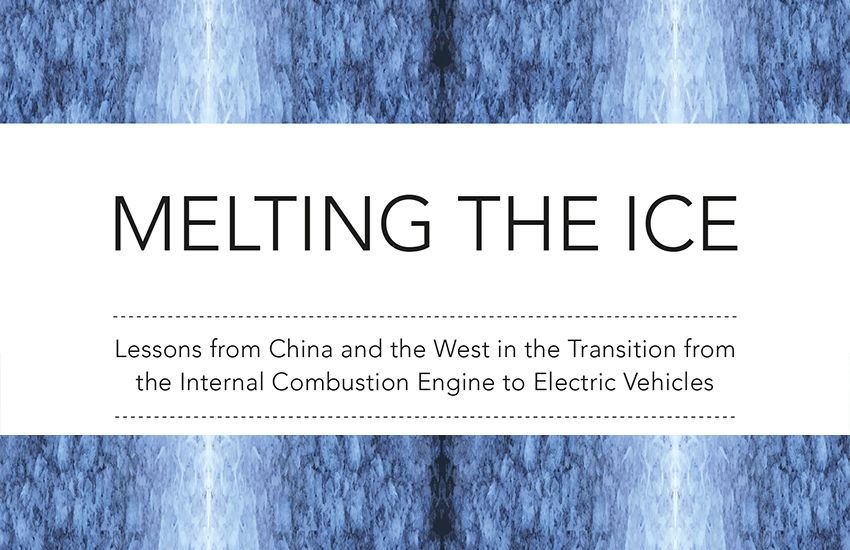Boston University’s Institute for Sustainable Energy Develops New City Planning Tools for Electric Vehicle Adoption.
“Melting the ICE” provides a first-time analytical framework to guide electric vehicle infrastructural investments
With cities at the forefront of electric vehicle (EV) adoption worldwide, Boston University’s Institute for Sustainable Energy (ISE) is giving municipal decision-makers a detailed blueprint for EV infrastructure planning in the new book Melting the ICE: Lessons from China and the West in the Transition from the Internal Combustion Engine to Electric Vehicles. It is clear in looking at why and how cities are driving EV demand that charging infrastructure is one of the most critical challenges for accelerating EV growth and decarbonising transportation.
ISE’s research in Melting the ICE (Internal Combustion Engine) lays out an actionable process to prepare for massive change in urban mobility—for the first time integrating a toolkit for analysing a city’s EV deployment needs with a holistic appreciation of how charging infrastructure and usage is interdependent on the electricity grid and other city systems and policies.
“We’re often asked whether the electric grid can handle widespread EV car charging,” said Peter Fox-Penner, Director, Boston University Institute for Sustainable Energy and co-editor, Melting the ICE. “This book demonstrates that there are many other equally important tactical and regulatory challenges as cities scale their EV infrastructure—especially when oncoming changes from shared mobility and autonomous vehicles are factored in.”
“The electrification of passenger vehicles is a critical decarbonisation pathway for urban centres like Boston leading on climate action,” said John Cleveland, Executive Director, Boston Green Ribbon Commission and co-author, Life After Carbon: The Next Global Transformation of Cities. “As this timely book documents, this transformation will not happen unless drivers have access to a ubiquitous, convenient, affordable, and fast vehicle charging infrastructure—in much the same way as we can all so easily find a gas station today. The great contribution of Melting the ICE is that it takes this discussion from the theoretical to the practical, showing us what we need to do, with great examples from cities around the world. As cities negotiate the multiple complexities of this transformation—getting the right business models, increasing charging speeds, creating consumer convenience, pricing it right, regulating where needed, etc., Melting the ICE will be a much-needed implementation guide.”
The underlying analysis in Melting the ICE is grounded in real-world case studies from cities around the world leading EV adoption, including Los Angeles and Brookline, MA in the U.S., Shanghai and Beijing, China, and Oslo, Norway. All provide illustrative examples of how a range of major variables—specifically EV-related incentives, public transit, traveling distance, housing types, workplace charging, and air pollution—can influence each city’s different Electric vehicle adoption and infrastructure demands. Melting the ICE synthesises these factors, using a practical, highly detailed framework that enables urban planners to measure and compare their city’s readiness to meet the demand for EV adoption and, in the process, prioritise solutions appropriate to that location.
At the same time, some key commonalities for successful city-level Electric Vehicle adoption deployments also emerge in evaluating real-world models, including cities with a clear goal, long-range plan, administrative and organisational support, and efficient processes and execution. The book delves into each case study city to explore why, how, and what they are doing to support EV’s and build up needed infrastructure.
Case studies:
Los Angeles, California: With one of the highest concentrations of EV’s in the U.S., LA is leading regional-scale efforts designed to aggregate deployment efficiencies and funding for EV infrastructure projects, an initiative that aligns with the transportation planning to support the 2028 LA Summer Olympics.
- China, Shanghai and Beijing: Two of China’s megacities have aggressively supported EV adoption by providing incentives above and beyond those offered by the central government, resulting in widespread public EV infrastructure deployment. But this impressively fast deployment has lacked standardisation, requiring equally as aggressive action to maximise effective EV use.
- Oslo, Norway: Boasting the highest EV market penetration in the world, Oslo achieved its present success in large part through demand-stimulating incentives, making it fast and easy to buy and use EVs. And now Oslo is leading the world in a new chapter of EV adoption, one that tackles how to support completing the transition to clean energy vehicles as national policies to phase out ICE vehicles take effect.
- Brookline, Massachusetts: Brookline, a small town relative to neighbouring Boston, has maximised its limited budget to lead on EV adoption by creatively leveraging the benefits of a regional EV infrastructure network. Bottom-up community engagement is largely credited with building support for EV infrastructure.
“We all love the concept of electric vehicles, but the complexities of delivering the vision make us wonder if a book on the subject would be a fantasy or science fiction,” said Fiona Woolf, former Lord Mayor of the City of London, 2013-14. “Happily this book is full of practical detail and real-world experience of pioneering cities that bring the vision to life. It is a gripping read and, like a good novel, is full of great stories and ideas.”
Download a free copy of ‘Melting the ice’ book
Melting the ICE is published by its editors who are affiliated with Boston University’s ISE and Questrom School of Business: Peter Fox-Penner, PhD, Director, ISE and Professor of Practice; Z. Justin Ren, PhD, Faculty Researcher, ISE and Associate Professor of Business Administration; and David O. Jermain, Senior Fellow, ISE and Adjunct Professor.
About Boston University’s Institute for Sustainable Energy
The Boston University Institute for Sustainable Energy (ISE) is a university-wide centre dedicated to facilitating the transition to a sustainable, climate-safe global energy system. Through interdisciplinary research, policy analysis, and collaborative engagement, our mission is to ensure that the energy systems of the world provide abundant, sustainable, and universally accessible energy services to both emerging and advanced economies. To learn more about ISE’s research on sustainable cities and next-generation transportation, visit bu.edu/ise.

